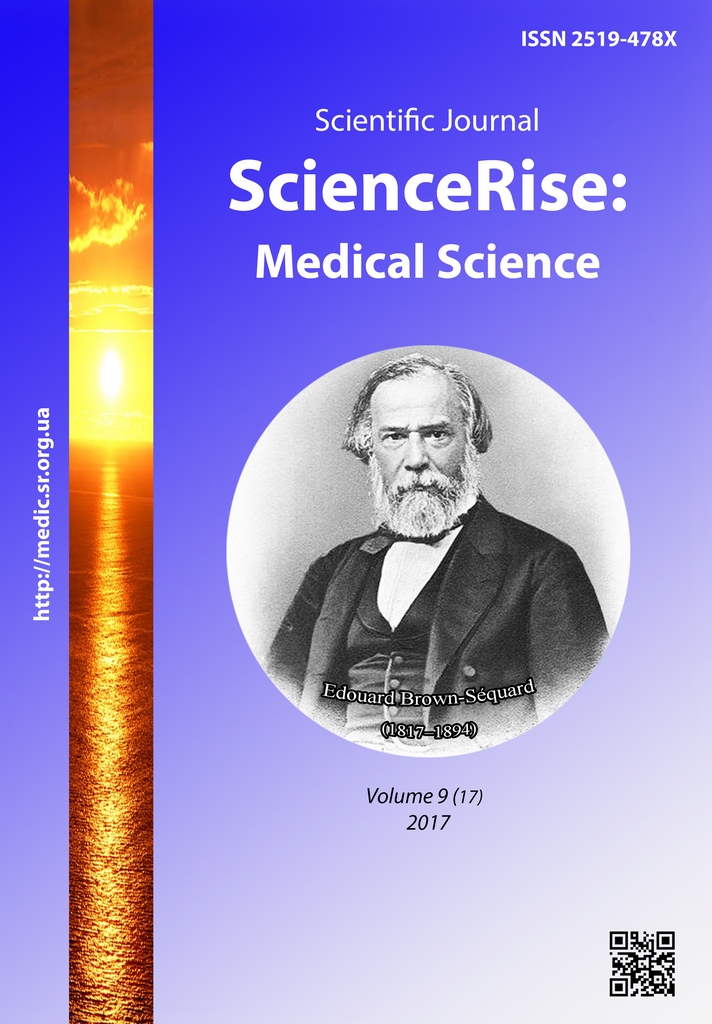Clinical and psychopathological features of formation and course of depressive disorders and suicidal behavior in cancer patients
DOI:
https://doi.org/10.15587/2519-4798.2017.111033Keywords:
suicidal behavior, cancer patients, depressive reaction, depressive episode, organic depressive disorderAbstract
Aim of research. The study of clinical and psychopathological features of formation and clinical course of depressive disorders and suicidal behavior in cancer patients.
Materials and methods of research. For attaining the set aim, the complex examination of 154 patients of both genders with a cancer pathology of I and II degree and diagnosed depressive disorders was realized, with observing principles of bioethics and medical deontology. The main group included 103 patients with suicidal behavior signs, the control one - 51 men without suicidal behavior signs.
Methods of research: clinical-anamnestic, psychodiagnostic, statistical.
Results. There were described the features of the clinical picture of depressive disorders in cancer patients at adaptation disorders, such as depressive reaction, moderate or heavy depressive episode, organic depressive disorder.
It was determined, that the true suicidal behavior prevailed in all patients (53,2 % of patients with depressive reaction, 56,5 % of patients with depressive episode, 51,2 % with organic depressive disorder), affective variant of suicidal disorder was observed in 38,1 %, 40,1 % and 44,1 % of patients, respectively; demonstrative-chantage suicidal behavior was observed in 8,7 % of patients with depressive reaction, 3,4 % of patients with depressive episode, 4,7 % – with organic depressive disorder.
Patients from the main group demonstrated clinical manifestations of anxiety and depression by the hospital scale, high anxiety and depression by Hamilton scale, great depressive episode by Montgomery-Asberg scale, patients from the control group were characterized by clinical manifestations of anxiety and subclinical depression by the hospital scale, moderately expressed anxiety and depression by Hamilton scale, moderate depressive episode by Montgomery-Asberg scale.
It was established, that the high level of suicidal risk and low level of consciousness of death in cancer patients with depressive disorders is a precondition of the suicidal behavior formation.
Conclusions.
1. A malignant neoplasm it is a psychotraumatic factor for a patient and leads to the development of depressive disorders and suicidal behavior.
2. The clinical picture of depressive disorders in patients with a cancer pathology is characterized by the predomination of mood inhibition, effect of sorrow and anxiety, immersion into the felling of an acute grief because of a cancer diagnosis, with narrowing of cognitive functions and predomination of the content of a psychic trauma in consciousness.
3. The main role in the formation of suicidal behavior of cancer patients is played by high indices of clinical scales of anxiety and depression, combined with the low level of death consciousness, burdened suicidal anamnesis
References
- Maruta, N., Yatsyna, A., Cherednyakova, O. (2014). Gender specificity of clinical manifestations of depressive disorders in male patients. XVI World Congress of Psychiatry. Madrid, 4, 51.
- Savin, A. I., Volodin, B. Yu. (2015). Features of psychogenically conditioned mental disorders and psychological characteristics of cancer patients with different tumor localizations (approach to the problem). Science of young – Eruditio Juvenium, 3, 82–86.
- Bambauer, K. Z., Zhang, B., Maciejewski, P. K., Sahay, N., Pirl, W. F., Block, S. D., Prigerson, H. G. (2006). Mutuality and specificity of mental disorders in advanced cancer patients and caregivers. Social Psychiatry and Psychiatric Epidemiology, 41 (10), 819–824. doi: 10.1007/s00127-006-0103-x
- Kozhina, G. M., Korosty, V. I., Zelenska, K. O. (2014). Mekhanizmy formuvannia ta shliakhy profilaktyky suitsydalnoi povedinki u khvorykh na depresyvni rozlady. Kharkiv: KhNMU, 64.
- Kozhina, A. M., Zelenskaya, E. A. (2013). Modern approaches to the therapy of depressive disorders. Ukrainian Journal of Psychoneurology, 21 (4 (77)), 90–93.
- Mukharovska, І. Р. (2016). Features of emotional condition cancer patients at the stage of primary treatment. Ukrainian Journal of Psychoneurology, 24 (4 (89)), 69–71.
- Holland, J. C., Breitbart, W. S., Jacobsen, P. B. et. al. (2010). Psycho-Oncology. Oxford: Oxford University press, 720. doi: 10.1093/med/9780195367430.001.0001
- Walter, F., Webster, A., Scott, S., Emery, J. (2012). The Andersen Model of Total Patient Delay: A Systematic Review of Its Application in Cancer Diagnosis. Journal of Health Services Research & Policy, 17 (2), 110–118. doi: 10.1258/jhsrp.2011.010113
- Markova, M. V., Piontkovska, O. V., Kuzhel, I. R. (2012). Stan is the perspective of rozvitku suhasnoi psychonecology. Ukrainian Journal of Psychoneurology, 20 (4 (73)), 86–91.
- Cancer in Ukraine 2013–2014. Available at: http://www.ncru.inf.ua/publications/BULL_16/index.htm
Downloads
Published
How to Cite
Issue
Section
License
Copyright (c) 2017 Svetlana Isayenko

This work is licensed under a Creative Commons Attribution 4.0 International License.
Our journal abides by the Creative Commons CC BY copyright rights and permissions for open access journals.
Authors, who are published in this journal, agree to the following conditions:
1. The authors reserve the right to authorship of the work and pass the first publication right of this work to the journal under the terms of a Creative Commons CC BY, which allows others to freely distribute the published research with the obligatory reference to the authors of the original work and the first publication of the work in this journal.
2. The authors have the right to conclude separate supplement agreements that relate to non-exclusive work distribution in the form in which it has been published by the journal (for example, to upload the work to the online storage of the journal or publish it as part of a monograph), provided that the reference to the first publication of the work in this journal is included.









